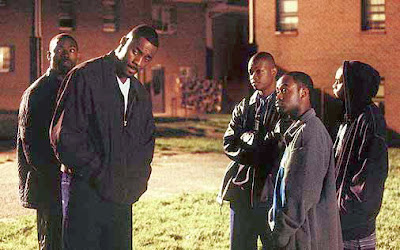The Wire: The Target
Season One, Episode One
Directed By: Clark Johnson
Written By: David Simon, from a story by Simon and Ed Burns
Read out “The Wire” Project here. Assume spoilers for the episode.
Or a series that I assumed about the dark and dangerous world of crime along the streets of one of the most destructive cities in the United States, the first episode of The Wire, “The Target,” opens with a humorous parable. Jimmy McNulty, played by Dominic West, listens to the tale of a kid shot for stealing money from a craps game named Snot. Snot would steal the money every week at the end of the game, but was never shot. When asked why he would be allowed each week despite this, the witness tells him, “[You] got to. This is America, man.”
On one level, a line like this is a deeply profound parable about the twisted nature of the American dream. But on another, this is a ridiculous and hilarious story not far from the works of Franz Kafka and Joseph Heller. The fact that Jimmy repeats the line to his partner as a joke shows that Simon, acting as writer for this pilot episode, knows that the trap he’s laid for us can also be seen as humorous from the right angle.
Much of “The Target” is about setting up the dangerous world that the characters of The Wire inhabit—where drugs and weapons are as common as water—but it’s also setting up what I believe will be the Kafkaesque nature of the Baltimore streets. Everything is a circle on end, where the choice is either drown oneself in sorrow, or simply laugh.
Consider the impetus for the season, a court case that Jimmy sits in on where D’Angelo (Larry Gillard Jr.) is being accused for murder. The two eye witnesses are lined up, but in walks Stringer Bell, an agent for a powerful crime organization, who simply sits in the back with a fine suit and a leather notebook. The eyewitnesses shut up, and Bell is on his merry way. This is a classic set up and payoff, and its only when Jimmy tries to break the system that everything goes to hell.
Jimmy explains to the judge that this is one of ten unsolved murders related to Avon Barksdale, the leader of the crime organization. Instead of getting a pat on the back, everyone in his unit is furious—Major Rawls chastises him for making this a case, point two middle fingers at him the entire time. Again, we have a scene built on dark pathos—speaking truthfully, even within the Baltimore Homicide squad, is a one way ticket to hell—but played essentially for laughs.
On the other side of the street, we also get to follow D’Angelo, who has to pay for his crime, but not through jail time (The other maxim established in this episode, every action has a consequence). D’Angelo is moved from working the towers to the low-rise projects. The visual look is one of absurd fear: it is daylight and children play around, but the addicts in the corners and junk thrown around make it a place of uncomfortable tension. Director Clark Johnson (he’ll direct the next episode, and one more this season), seems very much rehearsed in the style of Sidney Lumet. His camera is never flashy, but it captures details about the streets that hit the realism that Simon is aiding for. It’s also interesting to see a show shot in classic Academy ratio (4:3), so most shows now are shot in widescreen (1.68:1). The environments are more claustrophobic, though the shots not as expressive. It'll be curious to see other directors take on this material. For a pilot, you set the standards, and Johnson lays things out plainly, the way you should in a pilot.
The last thing I want to point out about this pilot episode is its context in the wake of September 11th. Jimmy visits a friend in the FBI, who has installed a live feed camera, along with two audio devices, to record a drug operation. This is the kind of supreme work that Jimmy needs, but as his friend reveals, it’s the last drug case in Baltimore—all the other funds are being diverted toward the new War on Terror. While this is a true statement, Simon frames it in this again ironic way; the best force out there to do the job is sent away on another mission. As one character refers to it later, he says not to call the drug war by the lingo; “Wars end.”
There are a number of other characters that Simon sets up in this opening 60 minutes—many who I didn’t exactly get the names of other characters, or exactly their positions—and boldly, he doesn’t make lay out the details all at first. This is a show that is built on complex relationships between people, places, and words that will slowly reveal themselves. Not all of it will make exact since. But there was never an explanation to why Gregory woke up as a beetle. Sometimes the most painful things are the funniest too.















